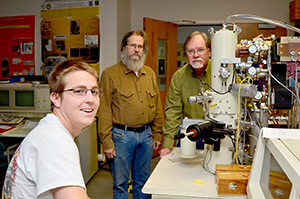Nov 6 2013
Three Appalachian State University engineering physics majors have been selected to work with Goddard Space Flight Center scientists on a two-year, nearly $300,000 project funded by NASA’s Smallsat Technology Development Program.
 Graduate student Brady Pearce, foreground, is working with Dr. Phil Russell from Appalachian State University’s Department of Physics, center, and Dr. John Allen on a NASA-funded project to characterize and analyze small spectrometer-on-a-chip devices for use in the Goddard Space Flight Center’s small satellite or CubeSats program. Allen, a research professor at Appalachian and an emeritus scientist at Goddard was awarded a nearly $300,000 grant for the two-year project. Pearce an engineering physics major is seated at an ultra-high resolution in-lens field emission scanning electronic microscope that can be used to analyze the chips for any imperfections or debris created in the manufacturing process. The Department of Physics and Astronomy’s focused ion beam laser (pictured) will be used to remove the imperceptions. Other students assisting with the grant are graduate student Frank Luca and undergraduate Greg Smalling. (Photo by Jane Nicholson)
Graduate student Brady Pearce, foreground, is working with Dr. Phil Russell from Appalachian State University’s Department of Physics, center, and Dr. John Allen on a NASA-funded project to characterize and analyze small spectrometer-on-a-chip devices for use in the Goddard Space Flight Center’s small satellite or CubeSats program. Allen, a research professor at Appalachian and an emeritus scientist at Goddard was awarded a nearly $300,000 grant for the two-year project. Pearce an engineering physics major is seated at an ultra-high resolution in-lens field emission scanning electronic microscope that can be used to analyze the chips for any imperfections or debris created in the manufacturing process. The Department of Physics and Astronomy’s focused ion beam laser (pictured) will be used to remove the imperceptions. Other students assisting with the grant are graduate student Frank Luca and undergraduate Greg Smalling. (Photo by Jane Nicholson)
Graduate students Frank Luca and Brady Pearce and undergraduate Greg Smalling will characterize and analyze small spectrometer-on-a-chip devices manufactured at the flight center for use in the center’s small satellite or CubeSats program. The chips are about the size of a business card. Their work will be directed by Dr. John Allen, a research professor at Appalachian who was awarded the grant. He is also an emeritus scientist at Goddard.
“The students will use the Department of Physics’ scanning electron microscope to look for imperfections in the chips and use a focused ion beam laser with nano-processing and nano-finishing techniques to clear any debris or imperfections from the chips, then test them using a helium neon laser for transmission of light through the chips’ channels before returning them to Goddard for final testing,” Allen said.
“The capabilities here are unique for most any university,” he said of equipment in Appalachian’s Department of Physics and Astronomy.
CubeSats are cube-shaped satellites that weigh less than 3 pounds and measure about 4 inches on each side. The small satellites typically are being developed for use in earth and planetary science research and military applications.
As part of the grant, the students will participate in testing at Goddard using a quantum cascade laser. They also will present regular reports to Goddard scientists and NASA grant managers in Washington, D.C.
“They will get to see a federal research lab functioning from the inside and have access to world-class talent. The experience will help them become comfortable developing ideas and defending their work to project managers,” Allen said. “That’s going to give them a leg up when they begin their professional careers.”
Allen retired as a Goddard scientist in 2008. He said he didn’t retire from science, just from federal service. He is one of five research professors at Appalachian who are given office space and access to equipment to continue their grant-funded research, but are appointed as research faculty rather than tenured or tenure-track full-time faculty.
“There are an enormous number of people who are retired or who are planning to retire who want to continue working in science, including writing proposals for funding and working with students, but they do not want to work full time,” he said. “This program gives us a place to ‘hang our hat,’ write grant proposals, contribute to the research and teaching mission of the university and benefit from the administrative support we can receive at a university.”
Anthony G. Calamai, dean of the College of Arts and Sciences, said, “Bringing senior scientists to Appalachian who are moving on in their careers and their lives to work with our faculty and students is generating real rewards for our college.”
Other research scientists in the college are Barry Kurtz, computer science; Greg Marland, geology and Research Institute for Environment, Energy and Economics; Anton Seimon, geography; and James Solinski, engineering physics.
In the short time that the senior scientists have been appointed as research faculty, their work has generated more than $500,000 in external funding to Appalachian. They are also involved with other proposals involving Appalachian faculty and students that are underdevelopment or consideration for funding by agencies such as NASA, the National Science Foundation and the National Institutes of Health.